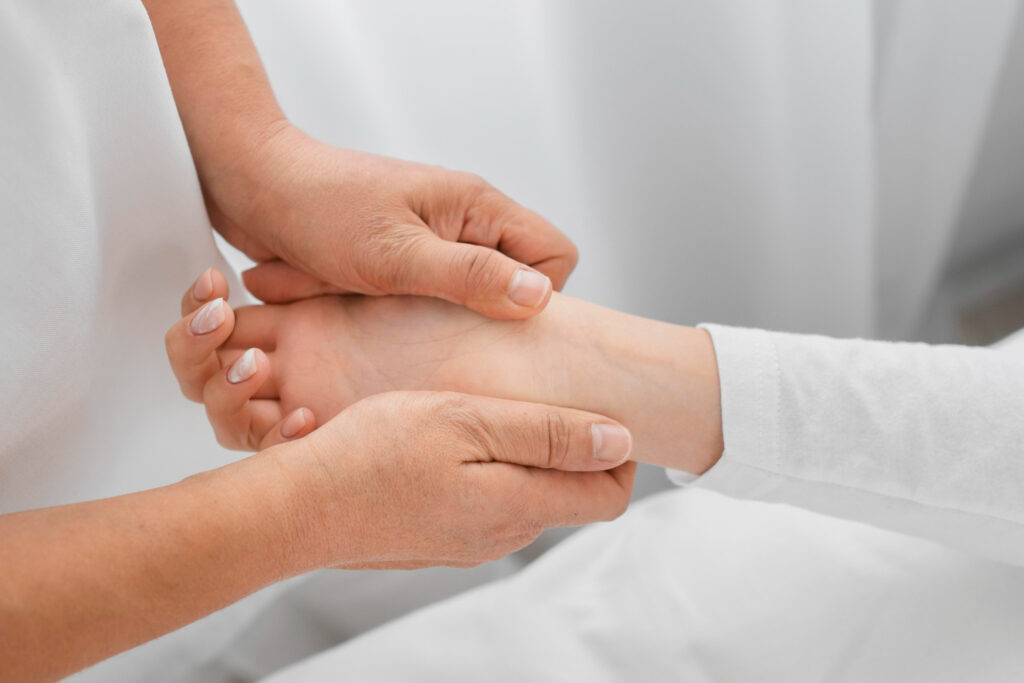
In this article
Pustular psoriasis is a rare and distinct type of psoriasis, an inflammatory skin disorder. It is characterized by the presence of white or yellow pus-filled bumps, known as pustules, on red, inflamed skin. These pustules are not infectious but are accompanied by severe itching, burning sensations, fever, and chills. This condition arises from an overactive immune system, and its flare-ups can be triggered by stress, infections, and certain medications.
Prevalence and Affected Areas
Although pustular psoriasis affects about 3% of those with psoriasis, it can also occur in individuals without any prior history of psoriasis. The condition can develop on any part of the body but is most commonly found on the palms of the hands and the soles of the feet. While pustular psoriasis can be painful and challenging, various treatments can help manage and alleviate symptoms.
Types of Pustular Psoriasis
There are three primary types of pustular psoriasis, each defined by the location and nature of the pustules:
- Palmoplantar Pustular Psoriasis (PPPP): This is the most common type, affecting the palms and soles. PPPP is chronic and can be difficult to treat, though periods of remission are possible.
- Generalized Pustular Psoriasis (GPP): Also known as von Zumbusch psoriasis, GPP involves widespread pustules across the body and is associated with systemic symptoms like fever, chills, fatigue, and joint pain. GPP typically occurs in sudden flares followed by remission periods.
- Acrodermatitis Continua of Hallopeau (ACU): This rare form affects the tips of the fingers and toes, causing persistent pustules that can spread and affect the nails, leading to nail loss.
Symptoms of Pustular Psoriasis
Each type of pustular psoriasis presents unique symptoms:
- PPPP Symptoms: Large yellow or white pustules on inflamed skin, burning sensations, itchiness, scaly patches, and cracked or painful skin. These symptoms can hinder daily activities involving the hands or feet.
- GPP Symptoms: Severe and widespread pustules, fever, chills, rapid heart rate, headache, loss of appetite, nausea, and muscle weakness. GPP flares can last for weeks and are followed by remission periods.
- ACU Symptoms: Pustules typically develop on one finger or toe, often under the nail bed. As ACU progresses, pustules spread to other digits, causing changes in nail shape, color, and texture, and thickened skin with scaly patches. The condition is chronic, with recurring pustules forming in previously affected areas.
Causes and Risk Factors
Pustular psoriasis is caused by an overactive immune system that mistakenly attacks healthy skin cells, leading to an overproduction of white blood cells that accumulate in the skin’s outer layers, causing inflammation and pustule formation. Genetic factors, such as mutations in the IL36RN gene, may play a role.
Triggers include stress, UV exposure, bacterial infections, medication reactions, stopping immunosuppressant medications, pregnancy, and smoking. Specific triggers may increase the likelihood of certain types of pustular psoriasis, such as finger or toe injuries for ACU, menstruation for GPP, and contact with allergic metals for PPPP.
Diagnosis
A dermatologist diagnoses pustular psoriasis through a combination of medical history, lifestyle habits, symptom analysis, and physical examination. Diagnostic tests may include blood tests, skin or nail cultures, and skin biopsies to confirm the diagnosis and rule out other conditions.
Treatment Options
Treatment aims to relieve symptoms, reduce pustules, and prevent complications. The approach varies by severity and type:
- PPPP Treatment: Topical medications, gauze or bandage coverings, light therapy, vitamin A oral retinoids, and synthetic vitamin D.
- GPP Treatment: Immediate medical attention, often requiring hospitalization. Treatments include biologics like Spevigo (spesolimab), oral retinoids, and immunosuppressants like methotrexate or cyclosporine.
- ACU Treatment: Similar to PPPP, with additional options like PUVA therapy to clear pustules.
Preventing Flares
While there is no guaranteed way to prevent pustular psoriasis, the following strategies can help reduce flare frequency and severity:
- Manage stress with relaxation techniques like meditation and spending time in nature.
- Maintain a proper skincare routine using fragrance-free products.
- Avoid harsh soaps and minimize skin scrubbing or scratching.
- Quit smoking.
- Identify and avoid personal triggers.
Related Health Conditions
People with pustular psoriasis may also develop other health issues, such as:
- Psoriatic Arthritis (PsA): An inflammatory arthritis causing joint pain, stiffness, and swelling, affecting about 26% of those with GPP.
- Inflammatory Bowel Disease (IBD): Individuals with psoriasis have a higher risk of IBD, including Crohn’s disease and ulcerative colitis, due to shared genetic and immune response factors.
- Anxiety and Depression: Chronic conditions like pustular psoriasis can lead to emotional stress, increasing the risk of anxiety and depression, which in turn can trigger flare-ups.
Living with Pustular Psoriasis
Living with pustular psoriasis can be challenging both physically and emotionally. While there is no cure, effective treatments are available, and ongoing research continues to improve treatment options. By working closely with healthcare providers, avoiding triggers, and adhering to a treatment plan, individuals with pustular psoriasis can lead fulfilling, active lives
A Quick Review
Pustular psoriasis is a rare, severe form of psoriasis marked by white or yellow pus-filled bumps on red, inflamed skin. Common types include palmoplantar pustular psoriasis (affecting hands and feet), generalized pustular psoriasis (widespread pustules), and acrodermatitis continua of Hallopeau (affecting fingers and toes). Treatments range from topical medications to biologics and light therapy
FAQS
What is pustular psoriasis?
Pustular psoriasis is a rare form of psoriasis characterized by white or yellow pus-filled bumps (pustules) on red, inflamed skin. These pustules are non-infectious and often accompanied by symptoms like itching, burning, fever, and chills.
What are the types of pustular psoriasis?
There are three main types:Palmoplantar pustular psoriasis (PPPP): Affects the palms of the hands and soles of the feet.Generalized pustular psoriasis (GPP): Involves widespread pustules over the body.Acrodermatitis continua of Hallopeau (ACH): Affects the tips of the fingers and toes, often spreading and causing nail changes.
What causes pustular psoriasis?
Pustular psoriasis is caused by an overactive immune system that mistakenly attacks healthy skin cells. Triggers can include stress, infections, certain medications, UV exposure, and genetic factors.
Who is at risk of developing pustular psoriasis?
Anyone can develop pustular psoriasis, but those with a history of plaque psoriasis are at higher risk. Other risk factors include stress, smoking, pregnancy, infections, and medication reactions.
What are the symptoms of pustular psoriasis?
Symptoms vary by type but generally include:PPPP: Pustules on palms and soles, burning, itching, scaly patches, and cracked skin.GPP: Widespread pustules, fever, chills, rapid heart rate, headache, nausea, and muscle weakness.ACH: Pustules on fingers or toes, nail changes, and thickened skin.











